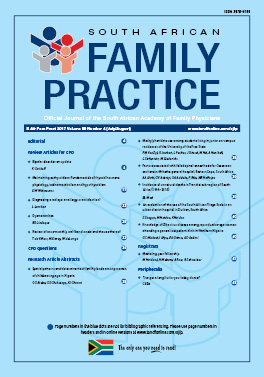An evaluation of the use of the South African Triage Scale in an urban district hospital in Durban, South Africa
Keywords:
audit, emergency centre, South African Triage Scale
Abstract
Background: Emergency centres in South Africa are among the busiest in the world and serve as entry points for hospital care for most of the population. The South African Triage Scale (SATS) is a validated tool introduced nationally in 2006 and intended to increase the efficiency of emergency centres through a process of prioritisation of the severely ill patient. The objective of this study was to evaluate the use of the SATS in a busy urban district hospital in Durban, South Africa. Methods: A chart review of triaged patients was performed. The hospital uses a one-page SATS sheet and manages both medical and surgical patients. The triage history, physiological parameters, application of discriminator lists, final triage code and outcome was audited and compared with findings from the patients’ clinical records. Results: The mean triage early warning score was 1.50 (95% CI 1–2) and average time to treatment was 59 min (95% CI 51–67). Essential bedside investigations were missing on some very ill patients, there was poor documentation in many fields and confirmed time to treatment was within recommended timescales for only 48% of patients. Use of the discriminator list resulted in over-triage of 66.7% and an under-triage of 14%. Some 76% of patients were discharged from the emergency centre, 15% were admitted and 5.5% were transferred out. Conclusion: Nurse-led triage has been successfully implemented at the emergency centre of this hospital using SATS but some notable gaps were identified. (Full text of the research articles are available online at www.medpharm.tandfonline.com/ojfp) S Afr Fam Pract 2017; DOI: 10.1080/20786190.2017.1307908
Published
2017-08-28
Section
Research Articles
By submitting manuscripts to SAFP, authors of original articles are assigning copyright to the South African Academy of Family Physicians. Copyright of review articles are assigned to the Publisher, Medpharm Publications (Pty) Ltd, unless otherwise specified. Authors may use their own work after publication without written permission, provided they acknowledge the original source. Individuals and academic institutions may freely copy and distribute articles published in SAFP for educational and research purposes without obtaining permission.

